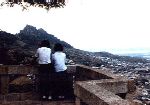| Settings from the novel |
 |
Mokpo, South Korea -- 1979. A pair of schoolgirls
take in the view from the treacherous staircase that
leads to the pavilions on Mount Yudal. The upper spur of
the mountain is on the left; Mokpo is on the right. |
 |
A view of Mokpo from the upper
heights of Mount Yudal. PAUL HARKIN lives here and works
in the City Health Center. |

|
A view of Mount Yudal from the neighborhood in which the Mokpo City Health Center is located. |

|
The Mokpo City Health Center. |
 |
Traditional rooftops in a typical neighborhood of Mokpo. |
 |
An example of one of the newer-style houses in Mokpo. |
 |
The author sitting among the
rooftops of an old residential part of Mokpo. |
 |
Chindo Island. This island, the home of
HAN MI JIN, is a mostly agricultural area of terraced
fields and rolling mountains. |
 |
Chindo Island. This is a stretch of
coastline between Mokpo and Chindo. |
 |
Korean Leprosy Institute. The KLI is
located near Seoul in St. Lazarus Village, a resettlement
village for leprosy patients and their families. JOEL
REYNOSO and later PAUL HARKIN live here. |
 |
Mokpo. The author with coworkers at the
Mokpo City Health Center's Tuberculosis Control Office. |
 |
A hanbok, the extraordinarily elegant traditional costume of Korea. |
| The Assassination of
President Pak Chong Hui -- October 26, 1979 |
 |
Within a day after the
assassination of President Pak, a shrine has been erected
in his honor in front of the Capitol Building in downtown
Seoul. (cf. Chapter 3) |
 |
A crowd of people listens nervously to the radio on the street near the baseball stadium in Seoul. |
 |
The Kwanghwa Mun intersection in downtown Seoul as seen from the men's bathroom in the Peace Corps office. |
 |
Mokpo. In the aftermath of the
assassination, the Martial Law Command has inexplicably
mounted a pair of machine guns on the roof of Mokpo's
train station. (cf. Chapter 3) |
![]()